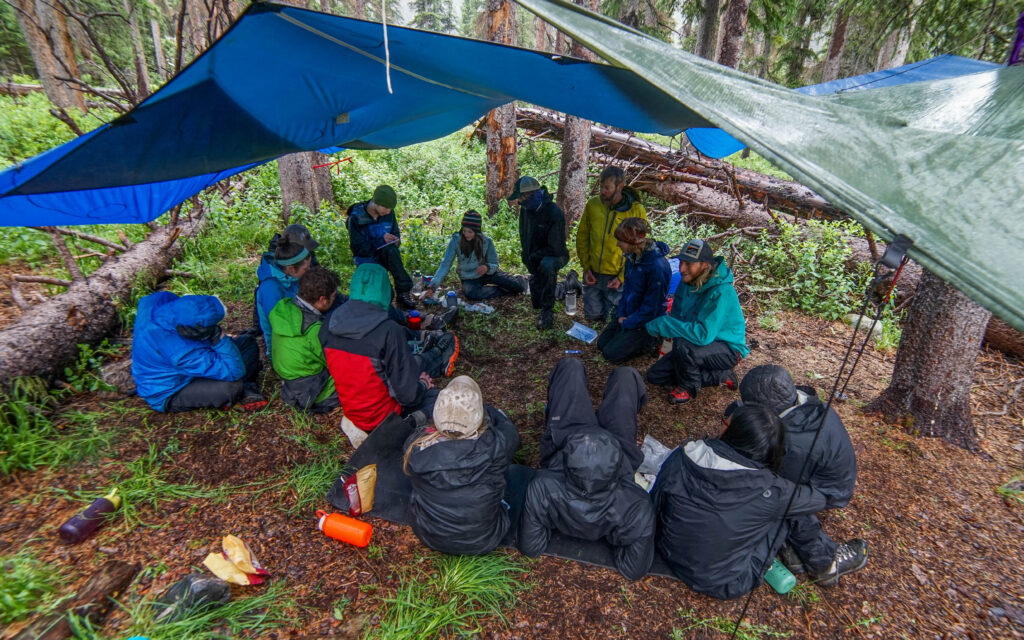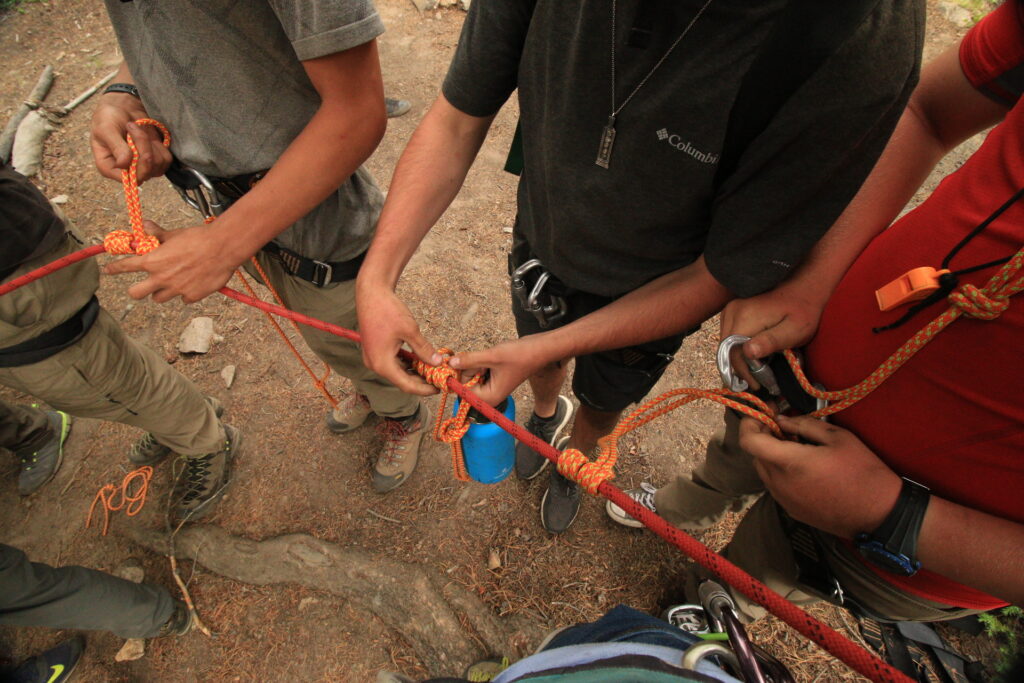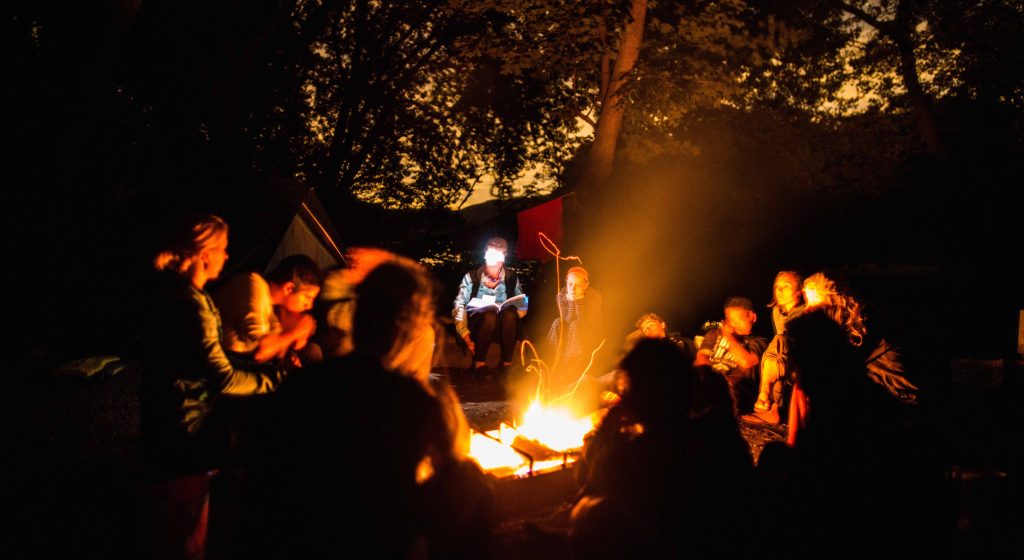2020 was one big ball of stress, and just because the year came to an end doesn’t mean that stress dissipates. Of course, we all want to press the reset button, but more so, we want to make amends and say farewell to the pain, suffering and stress we have collectively experienced and the habits that have ensued.
Our stress will continue into 2021, and guess what, 2022—it’s a part of life. This past year gave us the experience to think about things differently. Allowing us to call into question ours and others’ actions and habits as we’ve navigated new waters and communicated with more intention, compassion and care. As we ring in the new year, I hope we reflect on how our actions and words impact ourselves and our communities and what we can do to make things more harmonious in 2021.

Photo by Justin Brewster
The Power of Building Habits of Honest and Authentic Communication
A core component of the success of an Outward Bound course is the level of honest and authentic communication. When you’re stressed out or annoyed with someone, you still live and work among them. Your Outward Bound crew becomes your family—well, at least for a little while. It wouldn’t surprise me to hear that Outward Bound alumni are thriving in these stressful times we’ve been in. They know how to communicate in positive, solution-oriented and honest ways.
It’s a common misperception that Intercept courses are for struggling teens when really, the entire family is involved—that’s the beauty of the curriculum. Intercept courses respect individuals. Instructors, do their best to ensure everyone takes ownership of how they communicate and respond. Our hope on these courses is that the whole family starts to see patterns in their communication and then begins to rebuild their relationships around positive habits. Ensuring people feel heard and decisions are inclusive and respectful.

Photo by Ian McConnell
The Power of Positive Delivery and Response Habits in Communication
We will inevitably be at our wits’ end sometimes—and that’s okay. If we’re able to go into hard conversations being honest, managing our stress productively and supportively, and taking ownership when we don’t, we’ll be healthier and happier. Whether around the campfire with our crew or the dinner table with our family.
Knowing how to recognize in yourself and others a particular communication style, how to respond and what’s at the root of that type of communication will strengthen relationships in your household and deepen the mutual feeling of being respected, heard and valued.
Understanding Different Communication Styles
Below are the three types of communication styles and appropriate tactics to respond. Tools to help you spread compassion, be better communicators and build habits of empathy as we begin this year with more intention.

Photo by Alexa Geider
I’m assuming best intent when describing these communication styles. It reminds me that everyone is human. It can also be helpful to recognize that often when a person is communicating in one of these ways, it is the tip of an iceberg. The behavior is coming from a deeper concern or feeling. It takes time to chip away at that, building a relationship is key to working towards healthier communication. And remember, responding is communicating, too.
1. Aggressive
This type of communication is common when emotions are high and impulse control is low. It can also come from a person feeling threatened, in need of defending themselves or others or feeling a lack of power in the situation. I like to remind myself when I see aggressive behaviors in others or myself that it’s because that person is passionate about the subject, i.e. if their child comes home late from curfew and they yell, they are a ball of stress, worried about them.
The best way to respond (when you do not feel in imminent danger, of course) is to stay calm, allow them to release and focus on your presence at that moment. Aggressive communication is often the climax of stress. It’s hard to rationalize and compromise in these situations. Give the person time to relax and reset after exploding. Once enough time has passed and both parties are in a more grounded headspace, come together and talk about it.

Take time to pause and relax. Photo by Rikki Dunn
Aggressive communicators: it can be helpful to recognize the harm caused. No one likes being yelled at or talked down to, and you can’t move on without acknowledging that power difference. Talk through the things that lead up to the passionate expression and brainstorm other ways with your support system to help regulate your frustration.
Responders: make it clear how their communication style affects you, and when you regroup with them, establish boundaries around respectful communication habits. If any aggression is present, remove yourself if need be. Continue to talk about these behaviors and why and what they are coming from.
2. Passive-Aggressive
This type of communication is indirect, can be misinterpreted as sarcastic and is often exhibited when people feel scared of others’ reactions and/or feeling like being direct will cause tension. Conflict is a natural part of any relationship, and if we avoid it altogether, that can make matters worse. Passive-aggressive communication reminds me of the metaphor of sweeping it under the rug. We aren’t getting rid of it, we are just letting it build up. It’s complicated because it is a way for people to be humorous and sarcastic with one another.
Passive-aggressive communicators: using humor as a defense mechanism or as an excuse can be hurtful. If we talk about what we really mean instead of saying something “as a joke” we not only become better communicators but gain a better sense of humor.
Responders: the best way to respond is to be open, conversational and non-judgemental. “What do you mean?” “Sounds like you are frustrated.” Helping them pinpoint what’s bothering them and then offering solutions for the problem will better prepare them for the confrontation. Empowering them to be upfront with what they are feeling is a timeless life skill that will build confidence, empathy and self-awareness.

Photo by Larry Mishkar.
With teenagers, I often come back to, “You have to ask for what you need.” Young brains avoid confrontation because it scares them, especially with their peers, so they result in being passive-aggressive. They are saying what they want, but not what they actually feel or to the person that needs to hear it. If we as mentors and parents can make habits of calling-on passive-aggressive behavior (and yes, even with ourselves) we can help normalize disagreements within our relationships. Providing teenagers with the skills to work through them.
3. Passiveness
I tend to think of passive communicators with big, humble hearts because they don’t want to stir the pot, upset those they love and interact with, and can make do with what already is. On Intercept courses, this is the type of communication that is hardest to define and bring awareness to with students. Why? I’m still figuring it out. But, I think it’s because when we think of aggressive and passive-aggressive communication, we know it quickly—especially on the receiving end. If we are on the receiving end of passive communication, it’s hard to distinguish and think twice about. We move on.

Photo by Zach Shenal
Bringing awareness to passive communication can be helpful for those who do it so naturally because it helps establish their confidence and voice. Maybe they struggle to ask for help, which can result in them slipping under the radar. Maybe they’ve never felt heard before, so now they don’t even bother. The best way to respond is to ask them questions about things you’ve been noticing. Make space for them to share if you’re in a big group or a part of a large family. If that’s not beneficial, I suggest teaching them about and even practicing conflict resolution scenarios.
If we can help them understand conflict as natural and inevitable, then they’ll learn to engage with more confidence at a pace they are comfortable following and with communication habits that become second nature.
Intent vs. Impact
With all of these styles, it’s so important that when two parties feel misunderstood that you create time to come back together to talk about it. A helpful concept to think about is “intent vs. impact” when communicating. We don’t try to hurt people, but sometimes we do. If we can talk through the intent of our actions and words and the impact they have, we can strengthen relationships and our communication and conflict-resolution skills.

Photo by Ryan Harris
I hope this new year and beyond, we can come together to reflect on our hardships and appreciations and be honest about them. Different political views under one roof, thoughts about vaccines, arguments over what game to play—heavy topics or light-hearted ones.
We need to take care of ourselves and check-in with those around us, often. Continue to talk through the stress, recognize your communication style and use the framework of intent vs. impact to better understand those you are surrounded by and build habits of positive communication. Remember to still celebrate and love with all you got. Because that’s what it’s really about.
About the Author
Blaine Weiss is an outdoor Instructor who works primarily with the Intercept program of the North Carolina Outward Bound School. With a background in film and writing, she seizes the opportunity to fuse her interests in the creative arts with her love of the outdoors.




